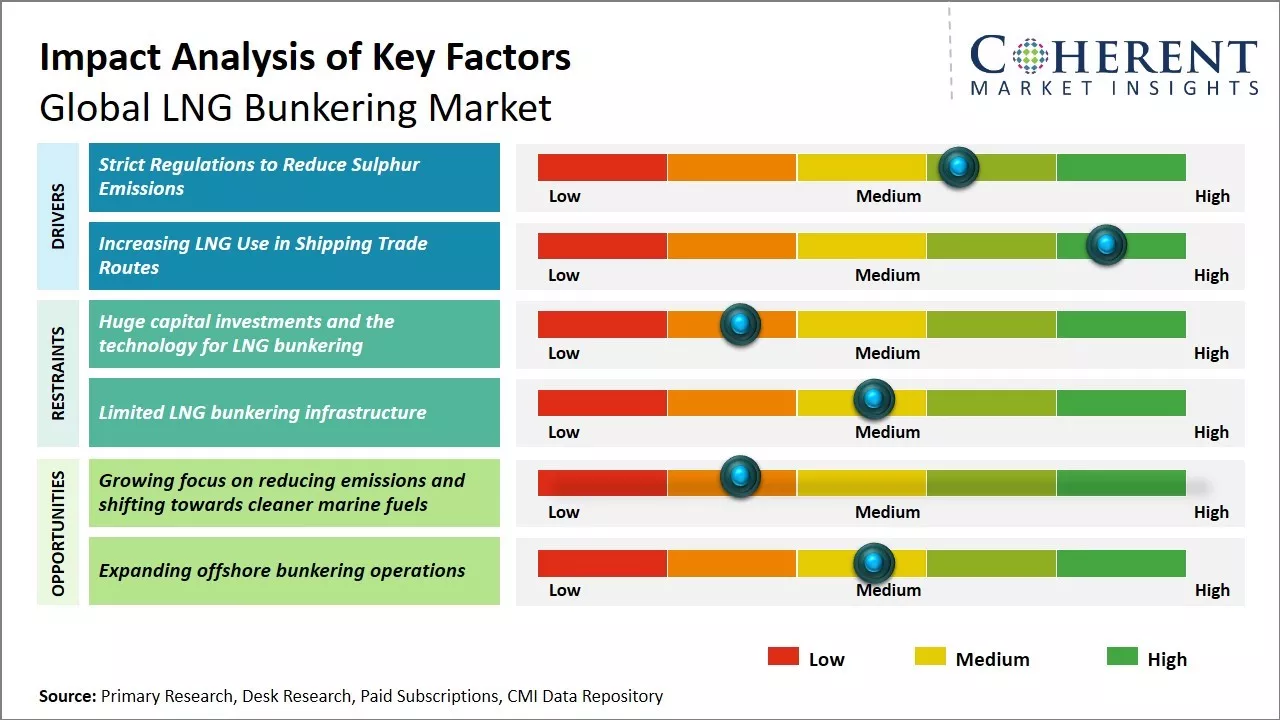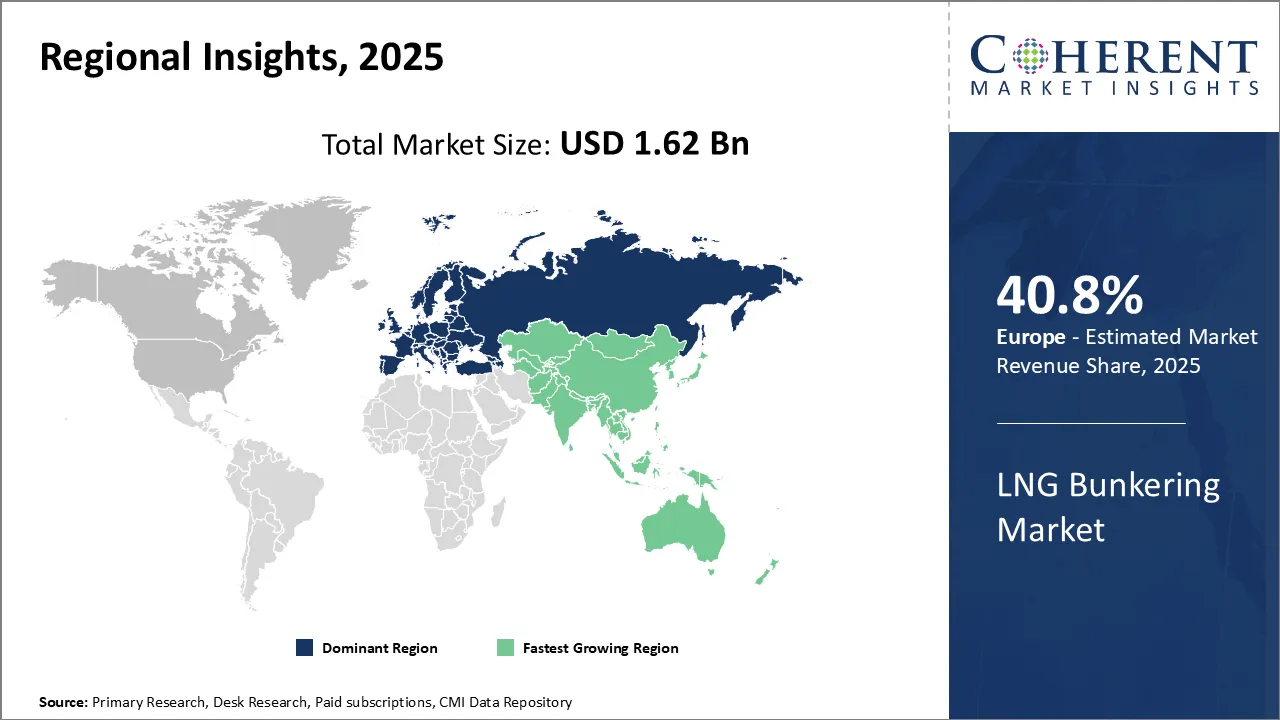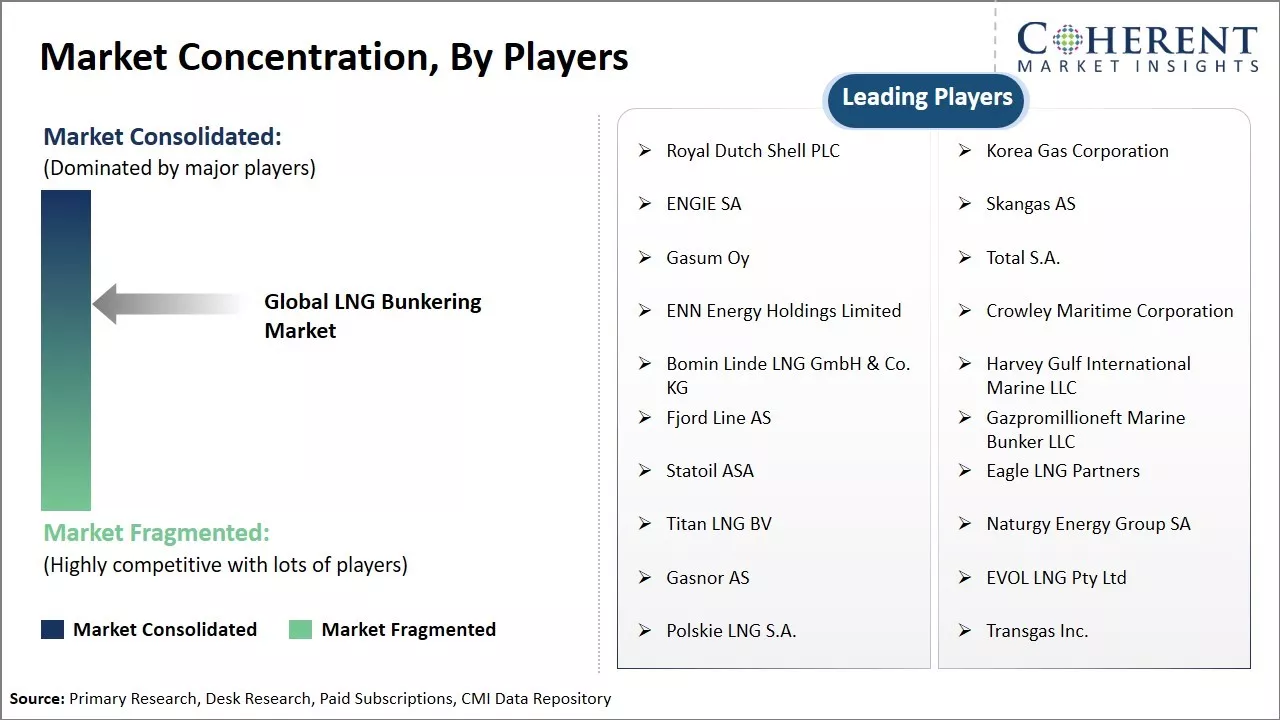The global LNG bunkering market is estimated to be valued at USD 1.62 Bn in 2025 and is expected to reach USD 10.44 Bn by 2032, growing at a compound annual growth rate (CAGR) of 30.5% from 2025 to 2032.

To learn more about this report, Download Free Sample
Strict environmental norms by International Maritime Organization to reduce emissions from ships and increased usage of clean and green fuels is driving the LNG bunkering market growth. The market is expected to witness significant growth during the forecast period. The growing demand for cleaner marine fuels to curb emissions and focus toward developing infrastructure for LNG bunkering across major ports is anticipated to drive the demand. In addition, rising seaborne trade and expansion of shipping fleet size require cleaner fuels and future-proof ships ahead of the impending regulations, which is also likely to boost the LNG bunkering adoption. Strong focus of various governments in establishing bunkering facilities and focus of major ports toward becoming early adopters of LNG are other factors that are expected to propel the market.
|
Current Events |
Description and its impact |
|
Implementation of FuelEU Maritime Regulations |
|
|
EU-Russian Energy Decoupling Timeline |
|
|
Vessel Fleet Deployment Surge |
|
Uncover macros and micros vetted on 75+ parameters: Get instant access to report
Ship-to-ship contributes 40.3% share of the market due to its operational advantages. The ship-to-ship segment dominates the global LNG bunkering market by product type owing to its inherent efficiencies and flexibility. Ship-to-ship bunkering allows LNG carriers to refuel other vessels directly through mid-sea transshipment operations. This bunkering method offers significant logistical and cost benefits compared to other modes of LNG transfer such as truck-to-ship. Ship-to-ship bunkering eliminates the need for specialized LNG receiving infrastructure like storage tanks and vaporizers that are required at ports. This allows vessels to refuel seamlessly anywhere along their international transit routes. The flexible and mobile nature of ship-to-ship operations also helps minimize downtime and deviation for refueling vessels. This ensures continuous, undisrupted cargo operations for LNG carriers as well as other vessels. For instance, in February 2025, Hong Kong launched its ship-to-ship LNG bunkering operation, with Kunlun Energy Co., a PetroChina-controlled company, reporting the first official bunkering at the southern anchorage of Cheung Chau. The company positioned its bunker vessel alongside the Zim Aquamarine (81,681 dwt) to load 2,200 tons of ultra-low temperature LNG. This is further accelerating the LNG Bunkering Market demand.
The cargo fleet application segment dominates the global LNG bunkering market due to significant growth in LNG carrier and container vessel fleets with 36.8% of the market share. An increasing number of cargo lines are incorporating LNG propulsion systems across new builds as well as retrofits to reduce emissions and comply with stringent environmental regulations. LNG offers tremendous benefits as a marine fuel for cargo vessels involved in international trade lanes. It emits nearly zero sulfur and particulate emissions compared to conventional bunker fuels. The use of LNG also helps ships meet the IMO's upcoming Emission Control Area (ECA) requirements and potential future regulations to curb greenhouse gases. Furthermore, larger container ships and very large gas carriers are prime candidates for LNG bunkering given their high fuel consumption.

To learn more about this report, Download Free Sample
Europe dominates the overall market with a share of 40.8%. Strict environmental regulations, modern port infrastructure, and the rising use of LNG-fueled vessels are driving strong growth in Europe’s LNG bunkering market. Leading ports such as Rotterdam, Zeebrugge, and Gothenburg actively expand their LNG supply capabilities with support from government incentives and green policies. Operators are increasingly adopting ship-to-ship bunkering to provide greater flexibility for cargo and cruise ships. At the same time, Europe is advancing investments in bio-LNG and synthetic fuels to lead the shift toward low-emission marine energy. For instance, in October 2024, Bunker One unveiled LNG bunker supply in northwestern Europe. Expanding its successful operations in alternative fuels, the company is adding physical LNG and mass-balanced LBM (Liquefied Biomethane) to its current fuel portfolio. Such initiatives are proliferating the LNG bunkering market revenue in Europe.
Asia Pacific countries are actively adopting LNG bunkering as stricter pollution regulations impact both international and domestic shipping routes. Ports and shipping companies are turning to LNG to cut sulfur, NOx, and particulate emissions, especially in busy maritime regions like China, South Korea, and Singapore. Key ports such as Singapore, Busan, and Shanghai are quickly building LNG bunkering terminals and related infrastructure. Governments and private firms are driving these developments by investing to meet growing demand, improve access, and position these ports as global LNG refueling centers. For instance, in April 2025, Osaka Gas Co., Ltd became the first gas utility company in Japan to offer LNG to vessels using this cleaner fuel by launching its shore-to-ship LNG bunkering service at its terminal.
Stricter emission rules from the IMO and U.S. agencies are driving transport companies to adopt LNG as a marine fuel. Ports like Jacksonville, Port Canaveral, Long Beach, and Port Fourchon are actively building LNG bunkering facilities to serve cleaner-fuel ships, including cargo vessels, tankers, ferries, and offshore support vessels. Developers are advancing major projects at JAX LNG in Jacksonville, Eagle LNG in Florida, and planned terminals in Tacoma and Houston. In Galveston, the Gulf Coast LNG Bunkering Project (GLBP) has secured final approvals and aims to launch operations by late 2027. For instance, The U.S. Department of Energy (DOE) has withdrawn a previous blanket order that applied LNG export rules to ship-to-ship LNG transfers for marine fuel. In a December 23, 2024 export permit to JAX LNG LLC, the DOE clarified that bunkering U.S.-produced LNG to foreign-registered vessels counts as an export, no matter where the transfer occurs.
Additional local bunker barges have made East China’s LNG bunker rates more competitive than those in Singapore. Expanded barge capacity in ports like Shanghai and Ningbo has lowered both spot and contract prices. PetroChina has carried out ship-to-ship LNG bunkering at Shenzhen’s Yantian port, enabling offshore refueling and reducing berthing times. This launch marks the beginning of offshore LNG ship-to-ship services in the Greater Bay Area. For instance, in January 2024, Chinese shipbuilder Hudong-Zhonghua, a subsidiary of China State Shipbuilding Corporation (CSSC), launched an LNG bunkering vessel for Anhui Changjiang LNG, the operator of the Wuhu LNG Terminal in Anhui Province. Such innovations are contributing to the LNG bunkering market revenue.

To learn more about this report, Download Free Sample
| Report Coverage | Details | ||
|---|---|---|---|
| Base Year: | 2024 | Market Size in 2025: | USD 1.62 Bn |
| Historical Data for: | 2020 To 2024 | Forecast Period: | 2025 To 2032 |
| Forecast Period 2025 to 2032 CAGR: | 30.5% | 2032 Value Projection: | USD 10.44 Bn |
| Geographies covered: |
|
||
| Segments covered: |
|
||
| Companies covered: |
Royal Dutch Shell PLC, Korea Gas Corporation, ENGIE SA, Skangas AS, Gasum Oy, Total S.A., ENN Energy Holdings Limited, Crowley Maritime Corporation, Bomin Linde LNG GmbH & Co. KG, Harvey Gulf International Marine LLC, Fjord Line AS, Gazpromillioneft Marine Bunker LLC, Statoil ASA, Eagle LNG Partners, Titan LNG BV, Naturgy Energy Group SA, Gasnor AS, EVOL LNG Pty Ltd, Polskie LNG S.A., and Transgas Inc. |
||
| Growth Drivers: |
|
||
| Restraints & Challenges: |
|
||
Uncover macros and micros vetted on 75+ parameters: Get instant access to report
Shipping companies are increasingly investing in LNG-fueled vessels to comply with tightening international emissions standards. Major operators across container, bulk, tanker, and ferry segments are choosing dual-fuel engines for flexibility and environmental compliance. This trend is supported by fleet modernization programs and long-term strategies to lower carbon footprints. The growing number of LNG-powered ships is directly boosting demand for bunkering services, especially along major global trade routes and high-volume port clusters.
The rising focus on sustainability fuels demand for renewable LNG alternatives. Bio-LNG and synthetic LNG provide near-zero carbon emissions, appealing to environmentally conscious ship operators and regulators. Scaling production and distribution of these green fuels presents an opportunity for LNG bunkering companies to differentiate their offerings. Collaborations with energy producers and governments can accelerate green LNG adoption, leveraging existing LNG infrastructure while meeting evolving regulatory requirements and market expectations for cleaner maritime fuels.
Share
Share
About Author
Sakshi Suryawanshi is a Research Consultant with 6 years of extensive experience in market research and consulting. She is proficient in market estimation, competitive analysis, and patent analysis. Sakshi excels in identifying market trends and evaluating competitive landscapes to provide actionable insights that drive strategic decision-making. Her expertise helps businesses navigate complex market dynamics and achieve their objectives effectively.
Missing comfort of reading report in your local language? Find your preferred language :
Transform your Strategy with Exclusive Trending Reports :
Frequently Asked Questions
Joining thousands of companies around the world committed to making the Excellent Business Solutions.
View All Our Clients